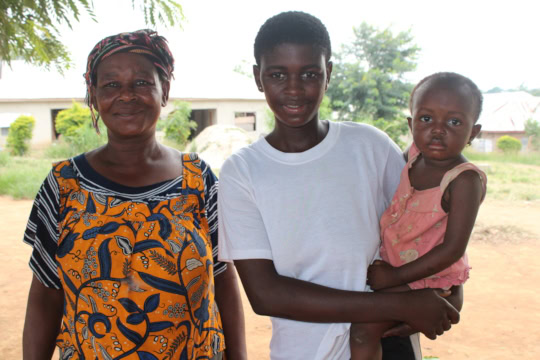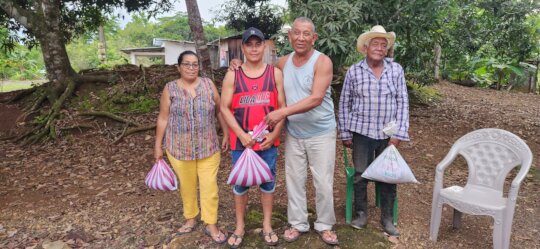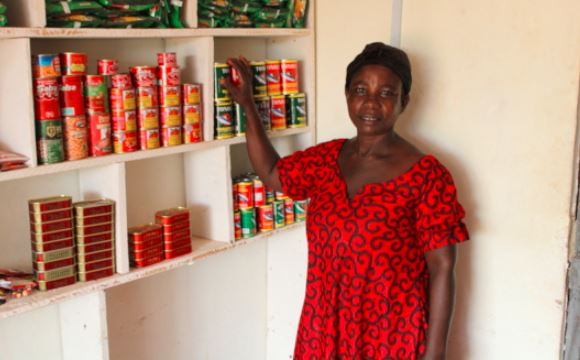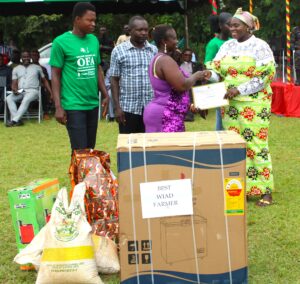Kontomire gathers to celebrate QPM feeding program

Children sing QPM koko song
By Nora Tobin, Executive Director
Yesterday I visited the community of Kontomire to see first-hand how the QPM feeding program is progressing after one year of operation. The journey began early, with a 90 minute drive from the office to the rural village. The final 6 miles involved a lot of bumping and jostling as Benjamin, Self-Help’s country director in Ghana, deftly navigated around the gaping holes in the road that would have taken the truck out of commission for a day or more. He noted that this community was particularly grateful for Self-Help’s support, since few NGOs would be willing to work with such a remote community due to the challenges of transportation. As we turned on to that final stretch, Bridget climbed in with her infant son Fifi to join us for the rest of the journey. Bridget is a junior high school teacher, but due to lack of residential housing at the school, she commutes more than an hour to work each school day if she pays for a taxi, or longer if she goes by food on the treacherous road.
Upon our arrival in Kontomire, we met with the teachers, who shared that the program is “an immense benefit” because it helps them to relate to kids, and for that they are very grateful. The main challenge is that the program depends heavily on the willingness of the parents and community members to donate QPM. To address this challenge, the community secured a ½ acre plot to cultivate QPM, and harvested 1 ½ of the 5 bags of QPM needed for the school year. They are also working with the chief to secure an additional ½ acre plot along the edge of the school grounds for the teachers and junior high students to cultivate for an additional maize supply. They would like to extend the feeding program beyond the KG1, KG2, and class 1 up through the junior high school, but understand that the feasibility depends on a consistent supply of maize.
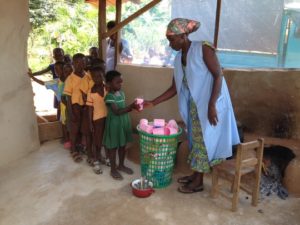
Auntie Nana, caterer, serves students QPM porridge
After the meeting, we spoke with the caterer, Auntie Nana, who prepares the QPM porridge each morning – called “koko” locally. She said that before the feeding programs were started, many children reported sick and went home. But now that they are eating daily, their “sicknesses” – more likely actually hunger pains – have subsided, allowing them to spend more time in the classroom and attentive. The enclosed kitchen where she prepares the porridge was built by the community with material contributions from Self-Help, and is well-maintained.
Then began the main event: an assembly of the entire community in which the chief, head teacher, country director and I all addressed the community, recognizing how much progress has been made in our partnership, and challenging the parents to continue to support the program. Despite some wonderfully drumming between talks and lots of joyous song and dance, the highlight for me was when Mavis, Victoria, Yaa Angel, and Serwaa, student beneficiaries, sang about koko (the local term for the QPM porridge):
Go, go, go Go to school And eat koko QPM Koko is sweet! Koko is sweet! Koko is sweet!Another student, Mariama gave a speech of appreciation to SHI for offering free QPM breakfast for the past year. Then a group of students enacted a play recounting the true story from a few months ago in which community members who didn’t understand the QPM program went to the Headmaster with false accusations about the program, he clarified about the benefits of QPM and confirmed that the program really is free, and, once on the same page, everyone agreed that the program was in fact very worthwhile. Then the head teacher, Emmanuel, appealed to the community to provide the school with more chairs for students in class

Woman answers call to support community programs
1. The grade is more congested this year due to increased enrollment associated with the introduction of the feeding program last year – a very good problem to have.
Finally, the chief appealed to Self-Help for continued assistance in building a library and information communication technology (ICT) center in the coming year, since the community has recently gained electricity. This heightened interest in children’s education is new and an exciting sign of the community’s dedication to their children’s success. An appropriate building has already been identified, so Benjamin and I agreed that if the community continues to demonstrate support for the QPM feeding program by consistently donating the necessary maize, we would set about working to provide assistance in filling the ICT center/library with computers and books.
Your donations, which brought the feeding program to Kontomire in the first place, have made the difference in encouraging this community to better invest in their children. Thank you for your ongoing support!

